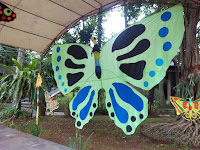In Pondok Labu, a museum for kitelovers
 Dozens of kindergarten students, accompanied by their parents, lined up in front of a wooden building at Jl. H. Kamang No. 38, Pondok Labu, South Jakarta, on a cloudy Friday morning. Then, the students entered the building, orderly following their teacher’s instructions.
Dozens of kindergarten students, accompanied by their parents, lined up in front of a wooden building at Jl. H. Kamang No. 38, Pondok Labu, South Jakarta, on a cloudy Friday morning. Then, the students entered the building, orderly following their teacher’s instructions.  “Mommy, that kite is so weird. I have never seen one like that. Can it even fly?” four-year-old Ali asked his mother, Erlina, 37. Ali was surprised at the Pegasus-shaped kite installed on the ceiling of the Indonesian Kite Museum. Other students were also mesmerized by the various forms of kites displayed there.
“Mommy, that kite is so weird. I have never seen one like that. Can it even fly?” four-year-old Ali asked his mother, Erlina, 37. Ali was surprised at the Pegasus-shaped kite installed on the ceiling of the Indonesian Kite Museum. Other students were also mesmerized by the various forms of kites displayed there.  Established in 2003 by beautician turned kite-preservation activist Endang W. Puspoyo, the museum houses dozens of kites. “I established the museum solely because I love kites. It is heartbreaking to see how rarely kites are flown in big cities like Jakarta,” she said at the museum, which is also her home.
Established in 2003 by beautician turned kite-preservation activist Endang W. Puspoyo, the museum houses dozens of kites. “I established the museum solely because I love kites. It is heartbreaking to see how rarely kites are flown in big cities like Jakarta,” she said at the museum, which is also her home. About 20 years ago, Endang decided to gradually opt out of her former profession to indulge her love of kites. In March 2003, Endang transformed her backyard into a museum to display her unique kite collection from across Indonesia. For instance, the museum showcases a kite from Southeast Sulawesi that is made of leaves.
 Visitors, like Ali and his mother, pay Rp 10,000 (US$1.09) admission for a tour, video and “paperfold” kite making practice at the museum.
Visitors, like Ali and his mother, pay Rp 10,000 (US$1.09) admission for a tour, video and “paperfold” kite making practice at the museum. “This museum is interesting because it has programs that actively involve its visitors,” Erlina said, while watching her son enthusiastically making a kite. “Our kids need to be introduced to our old toys, like kites,” she said, expressing her concern over her children, who like to spend hours of their spare time playing video games.
 The mother of two regretted that in Jakarta, she could not easily fly kites with her children due to lack of open space. “Our children are not allowed to fly kites around our housing complex. It is different from when I was young,” she said, recalling her childhood when she used to fly kites in her hometown in Bandung.
The mother of two regretted that in Jakarta, she could not easily fly kites with her children due to lack of open space. “Our children are not allowed to fly kites around our housing complex. It is different from when I was young,” she said, recalling her childhood when she used to fly kites in her hometown in Bandung.The difficulties in finding open space to fly kites in Jakarta are also shared by Endang. “They’ve turned open spaces into malls,” she said.
 Even the remaining open spaces, like the National Monument (Monas), was also not really suitable for flying kites because of the many trees, she said. “Frequently, I have to go to Marina beach in Ancol, North Jakarta, just to fly my kites,” she said.
Even the remaining open spaces, like the National Monument (Monas), was also not really suitable for flying kites because of the many trees, she said. “Frequently, I have to go to Marina beach in Ancol, North Jakarta, just to fly my kites,” she said. Endang not only promotes and preserves kites in her museum, she also promotes Indonesian kites around the globe. The museum participates in various kite competitions and festivals in countries like Australia, Britain, France, Korea and the United States.

At such festivals, she usually brings kites featuring Indonesian culture, with batik patterns or Balinese art for example. However, in spite of its role in introducing Indonesia to many countries, the museum is overlooked by the government, Endang said. (riz)
[Published at The Jakarta Post on April 23, pictures are taken by Muhammad Rizqi Arifuddin]



where are those pictures????? lol
ReplyDeletewell, when i read/hear the word kite. i always think happiness, fun, freedom, wind, fly away..
something that is closely related to some joyful and sincere happiness of a children.
and it's such a tragic that open spaces are scarce in big cities nowadays. it seems like sincere joyful happiness are hard to find also on that places. IMO
there you are, pictures on the museum :)
Deletehmm, it depends on how you perceive sincere and joyful happiness. I went to the city's most despair areas. But in those areas, I could find sincere and joyful happiness. I watched children laughing happily, forgetting the hardship they live with.
I also often go to some city's most dazzling places where this city's richest gather and waste their money. But, I can feel no joyful atmosphere there. I see them as empty vessel.
Take a look closer at your place :) you will find some interesting things in things that you usually overlook. :)
wise words my fried.. wise words... :D
ReplyDelete